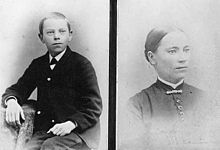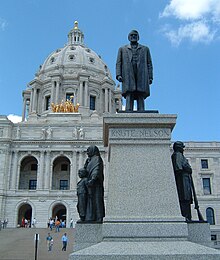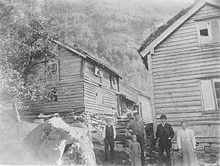Knute Nelson
Knute Nelson (born Knud Evanger; February 2, 1843 – April 28, 1923) was a Norwegian-born American attorney and politician active in Wisconsin and Minnesota.
Knud also worked, first as a house servant, then as a paperboy for the Chicago Free Press,[2] which gave him an early education, both because he read the paper and because he learned street profanity.
On May 27, 1863, after the 4th Wisconsin became a cavalry unit, Nelson was wounded in the Battle of Port Hudson, captured and made a prisoner of war.
He was deeply concerned about what he considered the ambivalent attitude among Norwegian-American Lutheran clergy toward slavery, and thought that too few of his fellow Norwegian Americans from Koshkonong had volunteered.
With Eli A. Spencer's help, he successfully ran for Dane County's seat in the Wisconsin State Assembly, starting its session on January 8, 1868.
[2] She was five months pregnant by the time of their marriage and, because of Nelson's poor relations with local Lutheran clergy, they were married by Justice of the Peace Lars Erdall in a private home.
He was put forward as a Republican candidate for the Minnesota Senate in 1874, running against banker Francis Bennett Van Hoesen, who was aligned with the Grange movement and state Anti-Monopoly Party.
Nelson was caught between his allegiance to the Douglas County Republicans, who were staunch Davis supporters, and his land office constituency, who favored Ramsey.
His constituents elected him in large part to resolve the gridlock that prevented the completion of the railroad extension from St.
It took several years for the various financial and political matters to be sorted out for the railroad, and Nelson played an active role throughout, both as an elected official, attorney, and businessman.
He secured rights-of-way for virtually the entire line from Alexandria to Fergus Falls, negotiating with many stakeholders for every tract of land.
After having flexed his political muscle by "bolting" from the campaign for a few weeks, he supported the Republican nomination of Jacob Stewart, a medical doctor from St. Paul, who won the election against Democrat William McNair.
This endorsement was not backed by the Norwegian-American community, who were concerned about Stewart's association with the Know Nothing Party and the apparent rise of a ruling class in society.
150 delegates fought over 80 seats, and after a scuffle in the main conference center, the Kindred and Nelson campaigns nominated their candidates.
Kindred spent between $150,000 and $200,000, but Nelson won handily, overcoming massive election fraud in Northern Pacific counties.
[10] The ensuing campaign against Democratic nominee Daniel Lawler and Populist Ignatius Donnelly centered on allegations of undue influence by railroad interests, tariffs, and ethnicity and patriotism.
When Nelson took the campaign to northwestern Minnesota, he had a minor physical altercation with Tobias Sawby, a local populist.
In his inaugural speech on January 4, 1893, he presented himself as a fiscal conservative with an affinity for education and dwelled on statistics related to various state services and for solutions.
The bill went through two rounds of voting with considerable horse-trading but in the end won narrowly, giving Nelson credibility as a political force.
He projected the image of a systematic and scientific reformer compared to such populist speakers as Mary Ellen Lease and Jerry Simpson.
He demonstrated hands-on leadership in the dry summer of 1894, when the Great Hinckley Fire spread across east-central Minnesota on September 1.
Nelson's campaign for Senate was a "still hunt," consisting of building support among incoming legislators while letting Washburn think he was running unopposed for the Republican nomination.
On September 21, 1894, the two candidates met at the Freeborn county fair in Albert Lea, where Nelson was asked directly whether he supported Washburn's candidacy or had his own designs on the seat.
Washburn was perceived as a wealthy, urban, aristocratic native Yankee from Maine, and Nelson as a hard-working immigrant from the Upper Country.
Nelson's victory reinforced the growing influence of areas of Minnesota outside the Twin Cities, and strengthened political awareness among ethnic Scandinavians in the region.
He spoke in his native dialect of Vossemål, slipping into Riksmål only when he felt it necessary to make an important political point.
His strategy was to align himself with celebrated national leaders, especially Theodore Roosevelt and Robert M. La Follette Sr., as they swung through the state campaigning for William McKinley.
Until that point, Nelson's political career was largely based on the issues of an unfolding economic frontier, with land development, immigration, and Gilded Age dynamics.
With the birth of the Progressive Era, the winds of reform started blowing more from the east than the west, and urban issues came more to the forefront.
In the crosswinds of the political movements of the time, Nelson chose a largely "moderate progressive" profile, accepting government intervention on some issues (such as antitrust matters) but opposing anything that smacked of socialism.






